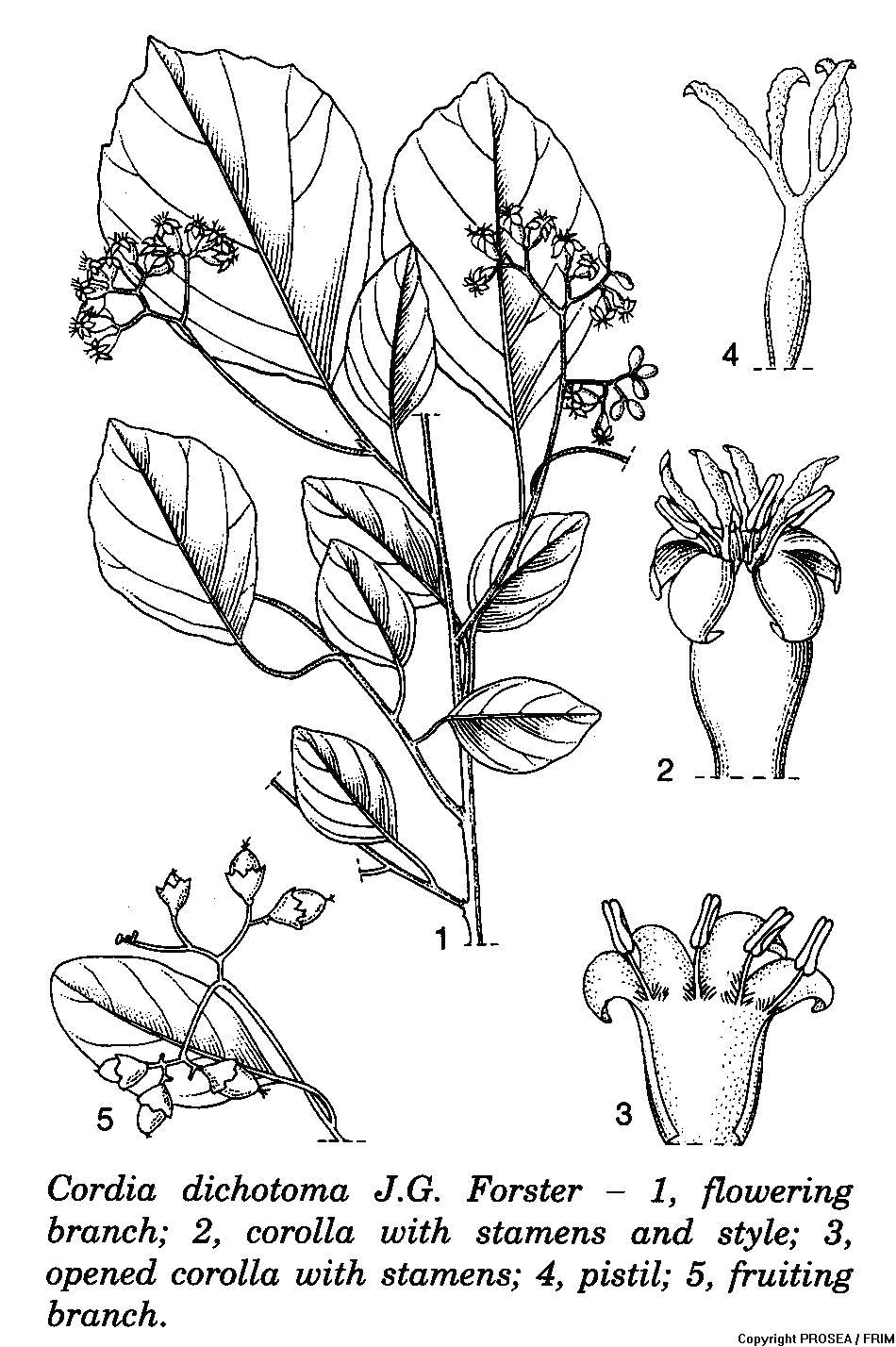Cordia dichotoma J.G. Forster
Family
Boraginaceae
Synonyms
Cordia obliqua auct. non Willd., Cordia myxa auct. non L., Cordia griffithii C.B. Clarke.
Vernacular Names
|
Malaysia |
Sekendal, sekendai, petekat (Peninsular). |
| English | Sebestan plum, soap berry. |
| Indonesia | Kendal (Javanese, Balinese), nunang (South-western Sumatra, Malay), toteolo (Halmahera). |
| Thailand | Phak mong, man muu (Northern), man dong (Eastern). |
| Philippines | Anonang (General), guma (Sulu), sinaligan (Iloko). |
| Myanmar | Thanat. |
| Laos | ‘man. |
| Vietnam | L[as] b[aj]c, l[as] tr [aws]ng, ti[ee]n d[aaf]u th[oos]ng. |
| Papua New Guinea | Cordia(General). |
| French | Capestan. |
Geographical Distributions
Cordia dichotoma occurs from northern India to southern China, southward throughout Southeast Asia to Australia and New Caledonia.
Description
C. dichotoma is a shrub or small tree measures about 5-10(-25) m tall, while the bole is measuring up to 60-100 cm in diametre. The bark surface is smooth and becomes fissured with age.
The leaves are alternate in arrangement, variable, ovate to oblong-ovate in shape with measure of 6-15 cm x 5-8 cm. Its base is acute, rounded or heart-shaped, apex acuminate to rounded, margins entire or somewhat undulate, membranaceous to leathery and devoid of hairs to sparsely hairy. It has a 1.5-4.5 cm long stalk.
The inflorescence that consists with 10-flowers is terminal or on slender lateral branches with 2-4 leaves, subcorymbose to subthyrsoid, lax, with pseudo-dichotomous branching and measures 5-11 cm long. The sessile flowers are male or bisexual, which are in two types on different trees. The sepal is cup-shaped, measures 3-5 mm x 3-4 mm, opening irregularly at the apex, hairy and increases its size to 6-10 mm long with age and becomes hairless. The cylindrical-bell-shaped petal measures 6-8(-10) mm long with white, yellowish-white or green colour, its tube measures 3 mm long with 4-6 lobes, oblong, spreading and reflexed. The stamens are as many as its petal lobes and are inserted at the petal with long protrude beyond. The superior ovary consists of 4-locular where 1 ovule is in 1 ovary compartment and the style is forked twice.
The fruit is drupaceous, ovoid, measures 10-13(-25) mm long and yellowish-white, orange or pinkish when ripe with 1(-3)-seeds. The outer mesocarp is pulpy, sticky and mucilaginous. The seed is egg-shaped, flattened, up to 6 mm long, while its endosperm is absent. The seedling is with epigeal germination. The young stem below the cotyledons is elongated and leafy where the first leaves are arranged alternately.
Ecology / Cultivation
C. dichotoma occurs in coastal hills, inland fringes of mangroves, also in open forests, thickets and savanna, from sea-level up to 500 m altitude, or planted up to 1500 m altitude, sometimes as a roadside tree. It tolerates a range of soils, but thrives on deep, moist, sandy loams, and does not grow well on dry, shallow, or gravelly soils. It occurs naturally in areas where the annual rainfall ranges from approximately 250-3000 mm. In areas with less than 500 mm rainfall, it grows in depressions and alongside streams.
Line Drawing / Photograph
Read More
1) Safety
References
- Plant Resources of South-East Asia No.12(2): Medicinal and poisonous plants 2.



